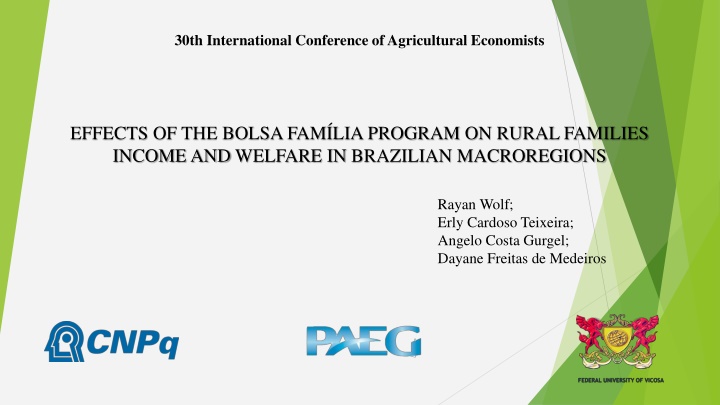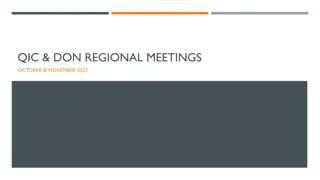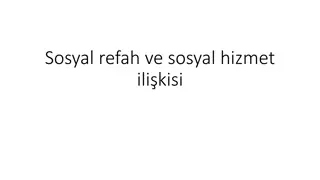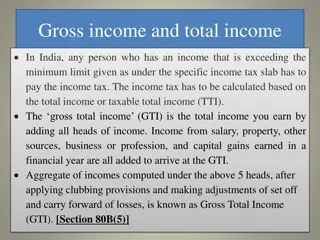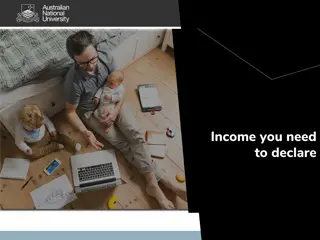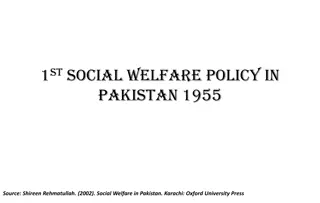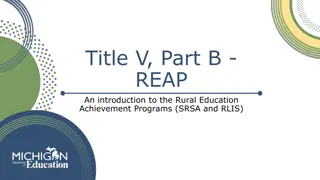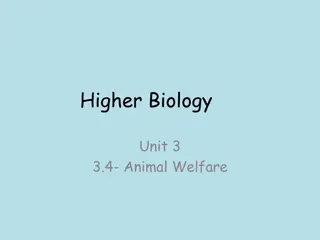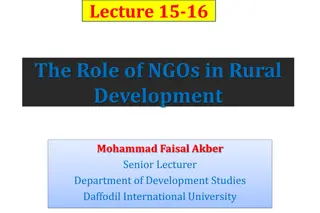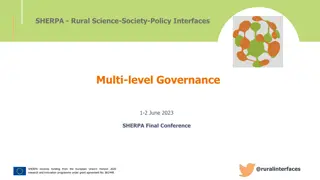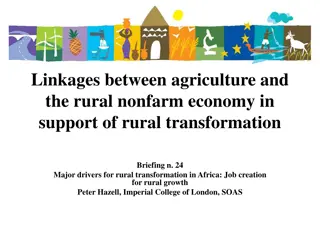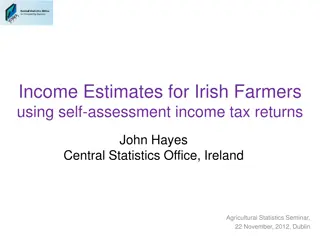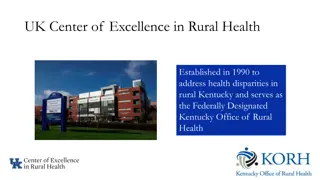EFFECTS OF THE BOLSA FAMILIA PROGRAM ON RURAL FAMILIES INCOME AND WELFARE IN BRAZILIAN MACROREGIONS
This study examines the impact of the Bolsa Familia program on the income and well-being of rural families across various macroregions in Brazil. The research conducted by Rayan Wolf, Erly Cardoso Teixeira, Angelo Costa Gurgel, and Dayane Freitas de Medeiros from the Federal University of Vicosa sheds light on the socioeconomic dynamics influenced by this significant welfare initiative.
Download Presentation

Please find below an Image/Link to download the presentation.
The content on the website is provided AS IS for your information and personal use only. It may not be sold, licensed, or shared on other websites without obtaining consent from the author.If you encounter any issues during the download, it is possible that the publisher has removed the file from their server.
You are allowed to download the files provided on this website for personal or commercial use, subject to the condition that they are used lawfully. All files are the property of their respective owners.
The content on the website is provided AS IS for your information and personal use only. It may not be sold, licensed, or shared on other websites without obtaining consent from the author.
E N D
Presentation Transcript
30th International Conference of Agricultural Economists EFFECTS OF THE BOLSA FAM LIA PROGRAM ON RURAL FAMILIES INCOME AND WELFARE IN BRAZILIAN MACROREGIONS Rayan Wolf; Erly Cardoso Teixeira; Angelo Costa Gurgel; Dayane Freitas de Medeiros FEDERAL UNIVERSITY OF VICOSA
1. Introduction Rural inequality is a serious problem in Brazil and indicates a bad income distribution agricultural policies should take into account new strategies to improve income distribution and reduce poverty in the countryside; Rural poverty is in many ways different from urban poverty, and the reasons are possibly different, leading to a distinction in the way of reducing or eradicating it (DE DEUS et al, 2015); Thus, it is important to evaluate the specificities of the rural area, which is an important exercise to treat rural poverty in a correct way 2
1. Introduction (cont.) Bolsa Fam lia is a Brazilian direct conditional income transfer program directed to families living in poverty, that is, receive less than US$25.75 per capita per month; The incidence of the Bolsa Fam lia Program is different among Brazilian regions; Rural poverty presents high spatial concentration in Brazil; it is important an analysis considering the Brazilian regions; The objectives are: to analyze the impact of the Bolsa Fam lia Program on the rural families income and welfare in Brazilian macroregions; 3 to analyze the impact of government transfers on the prices of primary factors capital and labor;
2. Methodology PAEG (General Equilibrium Analysis Project for the Brazilian Economy)) It is a computable general equilibrium package; It is multiregional worldwide (GTAP) and inside Brazil (large regions); It is static and multisector; The used data bases are PAEG 4.0 and GTAP 9.0; It follows the GTAPinGAMS formulation by Rutherford (1999); 4
2. Methodology PAEG (General Equilibrium Analysis Project for the Brazilian Economy)) Closures: Primary factors are in fixed supply; Full employment of primary factors; Primary factors are mobile among sectors and can be among Brazilian regions; Investment and capital flow are fixed; The balance of payment is constant (changes in the real exchange rate accommodate changes in trade flow); Government consumption may change with changes in prices and in tax revenue; 5 Tax revenue is subject to changes in sector production and consumption;
2. Methodology PAEG (General Equilibrium Analysis Project for the Brazilian Economy) Aggregation Sectors Regions Rice (pdr) Corn and other cereals (gro) Soybeans and other oilseeds (osd) Sugar cane, beet, sugar industry (c_b) Meat and live animals (oap) Milk and dairy products (rmk) Other agricultural products (agr) Food products (foo) Textile Industry (tex) Clothing and footwear (wap) Wood and furnishings (lum) Paper, pulp and paper industry (ppp) Chemicals, rubber and plastic industry (crp) Manufactured (man) Electricity, gas, water distribution (siu) Construction (cns) Trade (trd) Transportation (otp) Services and Public Administration (adm) Brazil - North Region (N) Brazil - Northeast Region (NE) Brazil - Midwest Region (CE) Brazil - Southeast Region (SE) Brazil - South Region (SUL) Rest of Mercosur (RMS) United States (USA) Rest of Naphtha (RNF) Rest ofAmerica (ROA) European Union (EUR) China (CHN) Rest of the world (ROW) 6
2.1 Methodoly - Source and Data Processing Consumptiom is disaggregated in ten rural and urban income classes; Rural and urban income were disaggregated in ten classes: a) income from primary factors; b) transfer between government and families; c) household savings; The consumption of rural households was disaggregated in the following way: a) Families in each Brazilian state are identified as rural or urban; b) The states are aggregated in regions; c) The families are disaggregated by income classes; d) The rural consumption is the remaining portion of the urban consumption; 7
3. Results Participation of the Bolsa Fam lia Program in total government transfers to rural families in the Brazilian regions Income Class Midwest Northeast North Southeast South 1st 2nd 3rd 4th 5th 6th 7th 8th 9th 10th 33.25% 20.61% 27.43% 14.19% 9.88% 8.42% 3.88% 3.18% 0.97% 0.67% 72.61% 48.30% 34.42% 21.97% 19.22% 13.37% 7.64% 4.10% 4.34% 1.67% 57.89% 53.48% 32.13% 28.01% 21.80% 16.16% 11.63% 7.79% 5.17% 1.06% 37.63% 29.30% 23.93% 20.26% 9.09% 7.29% 2.50% 1.94% 0.75% 0.15% 26.21% 24.59% 13.45% 13.49% 5.21% 5.43% 1.86% 0.87% 0.91% 0.29%
3. Results Participation of the Bolsa Fam lia Program on rural families income in the Brazilian regions Income Class Midwest Northeast North Southeast South 1st 2nd 3rd 4th 5th 6th 7th 8th 9th 10th 3.11% 1.27% 1.09% 0.45% 0.31% 0.20% 0.09% 0.03% 0.01% 0.003% 14.614% 4.762% 2.547% 1.119% 0.842% 0.471% 0.216% 0.064% 0.043% 0.006% 6.762% 5.184% 2.920% 1.877% 1.218% 0.559% 0.354% 0.122% 0.051% 0.012% 3.221% 1.766% 0.946% 0.476% 0.241% 0.172% 0.063% 0.031% 0.010% 0.001% 1.112% 1.184% 0.606% 0.329% 0.167% 0.129% 0.054% 0.016% 0.013% 0.002%
3. Results (Cont.) Impacts of the Bolsa Fam lia Program on rural families welfare in Brazilian regions (%) Income Class 1st 2nd 3rd 4th 5th 6th 7th Midwest Northeast North Southeast South 1.00 0.67 0.58 0.34 0.18 0.18 0.12 0.04 0.02 0.00 2.68 2.04 1.82 1.06 0.85 0.56 0.39 0.26 0.19 0.06 3.075 3.262 1.900 2.463 1.358 0.827 0.567 0.375 0.12 0.032 1.23 1.05 0.55 0.35 0.19 0.14 0.04 0.03 0.01 0.005 0.18 0.40 0.21 0.11 0.09 0.07 0.03 0.01 0.01 0.009 * percentage change 8th 9th 10th
3. Results (Cont.) Impact of the Bolsa Fam lia Program on the price of factors Factor Variation Midwest Northeast North Sotheast South Capital change (%) 0.001 0.007 0.006 0.001 0.001 Labor change (%) -0.002 -0.017 -0.022 -0.001 0.000 The inclusion of Bolsa Fam lia Program reallocate the government consumption of final goods Government decrease mainly the consumption from the service sector, wich is labor-intensive; The households increase mainly the consumption of capital-intensive goods; Thus, the effect of the Program is to reduce labor price and to increase capital price;
3. Results (Cont.) Effects of the Bolsa Fam lia Program on GDP and the main aggregates in Brazilian region C G I X M Region Multiplier ( %) ( %) ( %) ( %) ( %) Midwest 1.0021 0.021 - 0.021 - 0.009 0.009 Northeast 1.0103 0.160 - 0.502 - 0.071 0.047 North 1.0088 0.246 - 0.809 - 0.064 0.060 Southeast 1.0085 0.019 - 0.063 - 0.008 0.008 South 1.0016 0.009 - 0.025 - 0.002 0.004
4. Conclusion The Bolsa Fam lia Program increases rural families income and welfare; The welfare effect of Bolsa Familia Program to rural families is smaller than income effect; The Bolsa Familia Program increases capital price and reduces labor price; The conditionalities of the Bolsa Familia Program should consider labor qualification and student performance, beyond school attendance, to increase labor price and creation of human capital;
30th International Conference of Agricultural Economists EFFECTS OF THE BOLSA FAM LIA PROGRAM ON RURAL FAMILIES INCOME AND WELFARE IN BRAZILIAN MACROREGIONS THANK YOU! Rayan Wolf rayanwolf@gmail.com rayan.wolf@ufv.br FEDERAL UNIVERSITY OF VICOSA
